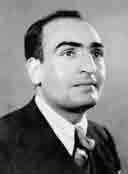 |
|
Pl. 11. Jamshid Soroush
Soroushian, Berlin, 1939. |
|
Rare it is to find caliber
and resolve so happily blended as in the person of the august Jamshid
Soroushian whose memory is exalted and perpetuated through these
commemorative volumes; it is hoped that this biographical note will do
some measure of justice to that revered memory. (For portraits of persons
mentioned in this article, refer to the following collection of historical
photographs.)
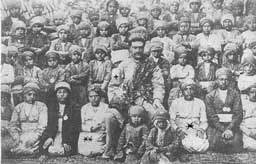 |
|
Pl 5. c. 1896. Students at
Kerman's Zartoshty school for boys.
Identified in the picture:
* Soroush Shahriar Soroushian (Jamshid Soroushian's father),
** Faridun Shahriar Soroushian (Jamshid's uncle),
+ Keikhosrow Shahrokh, at the time a young school teacher in Kerman. |
Going back along four
patrilinear generations before the late ra'is, we note Soroush
(Pls. 5, 8), Shahriar (Pl. 6), Khodabaxsh and Jām. Jām, it is believed,
originally hailed from Yazd. The provision of precise datings for this
early period is unfortunately impossible. His son Khodabaxsh lived and
worked in the mid-nineteenth century, out of Kerman’s Gabar Mahalle or
Zoroastrian Quarter to which the Zardushtis had long been restricted. With
the resilience and resourcefulness born of acute hardship, he journeyed as
petty commodity merchant south to Jupar and nearby villages eking out a
living to support himself his jobbing spouse and four sons. In those
uncertain times of high infant mortality exacerbated by great poverty and
dearth of health care, it became the norm to produce large families in the
strenuous hope that some, at least, from the generations to follow would
somehow survive.
Khodabaxsh himself
succumbed to the rigors of a severe winter ─ he would then at the utmost
have been in his early thirties, leaving the oldest boy Shahriar, aged
nine when this calamity overtook the family, to cope as best he could with
preserving his mother and younger siblings from an inevitable destitution.
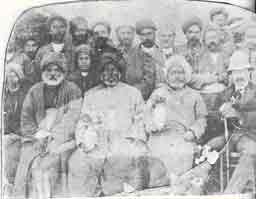 |
|
Pl. 6. 1897. Kerman: Gathering of
the Zoroastrians of Kerman. Seated in the front row (L
─
R) second person (with white beard) Mulla Gushtasp Dinyar (served as
4th president
of Zoroastrian Anjoman of Kerman), Dastur Rostam Jahangir Hormuzdi
(Head Mobed of Kerman, also served as the 3rd
president of the Kerman Anjoman), Shahriar Khodabaxsh Jām
(served as 5th president
of Kerman Anjoman), and Percy Sykes (later knighted by the British
Crown) who established the British interest section in Kerman. |
The compelling story of
Shahriar's providential encounter at a time of acute physical hardship
with the khazer folk and the subsequent revitalization of his
fortunes, forms part of the Soroushian family's stock of ancestral legends
to this day. As the young merchant's trade prospered, he teamed up with
the business house in Kerman of the respected Arbab (Mullah) Gushtasp
Dinyar (Pl. 6), formerly of Yazd, where his industry advanced him in
prominence. He duly married Mullah Gushtasp's daughter Banu (Pl. 8). After
Gushtasp Dinyar's demise, his wealth was distributed among Zoroastrian
communal relief projects; his residence was bequeathed for the purpose of
commencing schooling for Zoroastrian boys. Girls were denied all public
education; in the privacy of their homes, old customs and venerable
traditions were instilled, ensuring a rich continuity of cultural values
and deep familial ties whose enduringness over the generations triumphed
through an enforced exclusion into the full light of modernity. With
equality of status for women regained, as attested in the early history of
Zoroastrianism, the long repressed distaff side assumed its rightful place
in family and public life.
Banu Gushtasp, a
redoubtable lady, married Shahriar who came to be regarded as Pedar-e
mellat or Father of the Community. Banu herself became affectionately
recognized as memas, Grandma Banu, and thus was established the
Patriarchate of the Soroushians amongst whom the story of the arranged
marriage of their son Soroush to IranBanu, the daughter of Shahriar's
brother Esfandiyar had been planned, it is maintained, before their
respective births (with presumption, of course, of gender difference).
Shahriar's son, Soroush, grew up to accordingly wed his first cousin
Iranbanu, the very slightly younger daughter of Esfandiyar and his wife
Sultan-e Bahram.
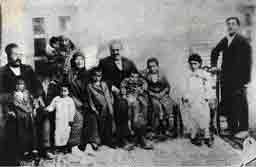 |
|
Pl. 8. 1920. Picture taken in
Kerman showing three generations of the Soroushian family. L─R:
(seated) Faridun Shahriar Khodabaxsh Jām
Soroushian, holding his oldest son Shahriar, Banu Faridun Shahriar
Khodabaxsh Soroushian (young child standing at his knee); Kaikhosrow
Faridun Shahriar Khodabaxsh Soroushian held by Mrs. Khorshid
Farmotani (standing ─
3rd row); Memas Banu (Jamshid Soroushian’s paternal grand mother),
Parviz Soroush Shahriar Khodabaxsh Soroushian (young boy at her
knee); Soroush Shahriar Khodabaxsh Jām
Soroushian, holding his third son Esfandiyar
Soroush Shahriar Khodabaxsh Soroushian; Jamshid Soroush Shahriar
Khodabaxsh Soroushian; Katayun Soroush Shahriar Khodabaxsh
Soroushian; Mr. Hormuzdyar Naderi (younger step brother of Memas
Banu) standing. |
Jamshid (Pls. 8, 11, 13,
15, 19), whose life story is encapsulated here was born in Kerman, like
his other siblings from this harmonious pre-ordained union on 8th November
1914 shortly after the outbreak of the Great War. The far-reaching
repercussions of that pan-European conflagration were to be felt
throughout Iran, and most keenly along the "buffer zone" of influence
between Imperial Russia and Great Britain. Now on a war footing, the Great
Game continued relentlessly to unfold, with Imperial Germany making an
aggressive bid for supremacy along the politico-military wedge recklessly
driven in the push for ascendancy by the conflicting Western Powers. Too
young to be affected by these insidious tensions foisted upon his beloved
Kerman, Jamshid spent his infancy nurtured in the bosom of his close-knit
family. He primarily attended the Kerman Zoroastrian boys' school up to
the best grade offered there. His higher education followed at the
day-school establishment conducted by Christian Missions, first in Kerman,
and then as a boarder at the Church Missionary Society School in Isfahan
run along English Public-school lines. Here students from different ethnic
and religious backgrounds were taught; Jamshid was the only Zardushti
pupil, which singled him out for ridicule of his religious beliefs and
attitudes. The school officials were more circumspect with regard to those
from Christian and Muslim backgrounds. Those irksome experiences served
only to strengthen Jamshid's faith and resolve him to inquire further into
his Zoroastrian heritage and his community's affairs and background ─ a
deep involvement ensued which, if anything, burgeoned throughout his life
and defined his future career. He became wholly committed to his people,
his family, and to a sound scholarship for which the Isfahan mission
school had unwittingly equipped him. His spirit and intellect bonded
wonderfully within him, begetting high ideals of life and of character,
and impelling him surely towards his goal of restoring a long awaited
glory upon the noble faith of his ancestors in the very heartland of his
beloved Iran.
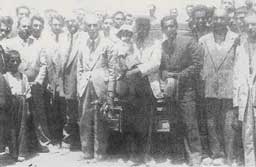 |
|
Pl. 13. 1949. Baghin (20 Miles
West of Kerman): Arbab
Sohrab Rostam Kaikhosrow Viraf Kianian (president of the
Zoroastrian Anjoman of Yazd
─
wearing a hat and holding his grand daughter Mahvash Jamshid Soroush
Soroushian) has accompanied Professor Ibrahim Pour-Davoud (standing
to his immediate right) to Kerman. Jamshid Soroush Soroushian
(president of Zoroastrian Anjoman of Kerman) is standing to
Professor Pour-Davoud's immediate right. Other well wishers, part of
the welcoming party have also posed for this photo session. |
An older sister Katayun
(Pl. 8) and a younger Mahindokht together with three brothers, Parviz
(Pl. 8), Esfandiyar (Pl. 8) and Hormuzd completed Jamshid's generation.
Shahriar the
well-remembered patriarch, had assiduously built up a modest agricultural
business through careful management of the several small-holdings around
Kerman. Under Soroush and his brother Faridun (Pls. 5, 8, 12), it further
expanded with land sales by Qajar royalty to land holders, and happened
also to include cultivable land near Tehran. This latter acquisition had
been facilitated through the kindly offices and good influence with the
Qajar families of Arbab Keikhosrow Shahrokh (Pls. 5), the then Zoroastrian
representative in the Majlis at the national capital.
Jamshid stalwartly resumed
his family's business activity whilst absorbing himself in penetrating
studies of his ancestral religion and civilization. He had encountered the
research work of the Parsi solicitor Dinshah J. Irani (the father of
Professor Kaikhosrov) who had twice visited Iran ─ once accompanied by
Rabindranath Tagore. Impressed with his profound interest in Zarathushtra
and the promulgation of his wonderful universalist message, and that of
his like-minded distinguished Iranian colleague Ibrahim Pour-Davoud (Pl.
13), Jamshid soon adopted the latter as mentor and revered teacher. Pour-Davoud
was long remembered by him for his tremendous qualities of heart and mind.
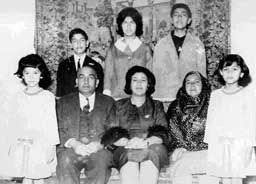 |
|
Pl 15.
March 1964. Kerman: Family
picture taken on the occasion of NouRuz at the family residence.
Front row L─R:
Armity Jamshid Soroushian, Jamshid Soroush Soroushian, Homayun
(Sohrab Kianian) Soroushian, KhorshidBanu Sohrab Kianian, Anahita
Jamshid Soroushian.
Second Row L─R:
Mehrborzin, Mahvash, and Soroosh Soroushian.
(Background: A custom décorative Kermani Carpet commissioned by
Jamshid Soroushian, capturing a historical scene of Achamedian
Emperor Xerxes and his queen Esther.) |
No ordinary bibliomane,
Jamshid found time to pursue his Zoroastrian studies and fulfill an
unselfish ambition for enlightening his co-religionists everywhere.
Remarkably, his religious interests and convictions were directed
outwards, yet held within the bounds of his intense nationalism. All the
works he was to produce in the field of historical and religio-cultural
research were in Farsi, and his comprehensive collection of literature on
these subjects reflected as much on the endeavors of Iranian savants as on
the scholarship of outsiders who had devotedly immersed themselves in
studies of the ancient Iranian civilizations.
Over the years he had
welcomed overseas visitors, students and investigators of this
far-reaching ancient culture, rejoicing in their company and in evaluating
their noteworthy contributions. He maintained a lively correspondence with
many scholars abroad and would visit them whenever possible during his
travels outside Iran. It is good to confirm that several papers reproduced
here are from his friends, colleagues and admirers who can easily and
appreciatively recall his spontaneous welcome and traditional hospitality
in his bustling Kerman home which many regarded as informal education
center. Thus Jamshid Soroushian's multifaceted personality ─ he was a
scholar, but even more a man of the religion and a leader of the community
─ explains the choice of papers included in this volume: not only articles
by scholars, but also contributions by friends and co-believers who wished
to testify their admiration for the man.
Kerman itself held a
sacrosanct place in Jamshid's heart. Has it indeed not been said of this
marvelous symbiosis of city and citizen by Shah Nematollah Valli,
Kermān dēl-e 'ālam-ast,
ā mā ahl-e dēlīm.
Jamshid had a formidable
acquaintance with the Shahnameh of Ferdowsi Tusi which he
tactically used with great effect and with much frequency in resolving
thorny situations demanding persuasion and diplomacy. It always worked! In
addition to his undoubted business acumen, his extensive erudition became
widely respected both among his fellow Zardushtis and those not of the
faith. He was elected to the high profile position of rā'is-e anjoman,
in which prestigious capacity he served as guiding light to his
beloved community. It is pointed out that he was the tenth occupier of
that office. His brother Parviz stood later as the twelfth incumbent.
Since boyhood Jamshid had
been afflicted with mild deafness. In later years this was to intensify to
the point of totality and it is recounted that in his last years he was
able to communicate only through his attentive lip-reading of close family
members. Throughout, his vitality remained undiminished and his unfailing
courtesy amply compensated his many anxious friends, associates and
guests.
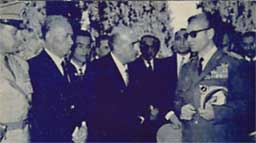 |
|
Representing the Zoroastrian community
during a royal visit to Kerman in 1964 by Shah Mohamed Reza Pahlavi |
Jamshid Soroush Soroushian
as scholarly author is best remembered for his Farhang-e bēhdīnān
the comprehensive lexicon of the dārī dialect extensively spoken
among the Zardushtis of Iran until quite recently. But not far behind in
importance ranking are his other published works including Savād āmūzi
va dabīrī dar dīn-e Zartušt (which bespeaks early universalist
education), Ba yād-e pir
muġān
(commemorating
the Magians), Rōšānibāxš (on early Zoroastrian esoteric
traditions), Tārix-e Zartuštiān-e Kermān dar in čand sad sāleh
(outlining past centuries' history of the Kermani Zardushtis),
Pand-nāme-ye Mohammad (putative instructions of Mohammad on the
treatment of vanquished peoples), Šāhnāme-ye haxāmenišiān (a
challenging work presenting subtle aspects of Ancient Iran's Achaemenid
dynasty), and Āb-e garmābe va pākīzākī nazd-e Zartuštiān-e Irān (on
traditional cleansing among the Zardushtis). Jamshid's last completed
work, Čāšt, (including chapters on the maltreatment by the Arabs of
the Zardushtis of Balochistan) has recently been posthumously published;
his unfinished set of chapters of an incomplete draft awaits editing with
a view to publication.
In the year 1946 Jamshid
married Homayun (Pls. 15, 19), the daughter of Arbab Sohrab Kianian (Pl.
13) of Yazd. She bore him five children over the course of a long and
steadfast marriage: the eldest daughter Mahvash Goodarz (Pls. 13, 15), was
followed by sons Soroosh (Pl, 15) and Mehrborzin (Pl. 15), and their twin
sisters Armaity Shahriari (Pl. 15) and Anahita Soroushian (Pl. 15).
His links with Yazd were
additionally reinforced through his studies on Yazdi history and culture,
and between the two ancient Zoroastrian stronghold cities, he thoroughly
imbibed and vigorously propagated the precepts of the Good Religion. His
long-time friend and editor of the Persian Section volume, Emeritus
Professor Bastani Parizi, remarked of him, "Jamshid expects his audience
in the span of fifteen minutes over tea with him to realize the merits of
the Dīn-e bēhī and to become believers in it!" Indeed a fervent
Zardushti!
|
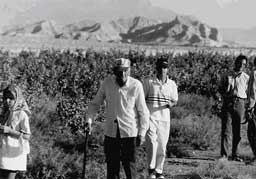 |
|
Pl. 19. Summer 1998. Jamshid
Soroushian inspecting a pistachio garden in Saidi (North-Eastern
Suburb of Kerman). His grand son, Vishtasp Mehr Soroushian is
walking behind him. Ruins of a 3rd century
C.E. mountainous fortress named after the Sasanian Shah Ardeshir can
be seen in the background. |
On his last visit away
from Kerman, Jamshid Soroush Soroushian suffered a stroke in Tehran and
expired on 28 February 1999. His remains were brought to his beloved home
city and there inhumed in the family plot, between his dearly revered
parents, in the Zoroastrian burial ground. A staunch traditionalist in
socio-religious matters, it is believed that he regretted the ending of
the system of exposure within dakhmas some two generations ago ─ (the Yazd
Manakji dakhma, however, remained in use until the early 1960's) ─ but was
of a mind which kept pace with changing events and new developments. His
humanitarianism and breadth of vision overrode considerations of ancient
usages when they could no longer continue to be validated. For him it was
the progressive Zoroastrian way, and he departed this life as he had lived
it: in dignity, peace and in the due fullness of time.
While Jamshid's heart was
devoted to his family, both domestic and extended, his soul was anchored
in Zoroastrianism. Inasmuch as he diligently attended to the family
business of agronomy which flourished under his careful stewardship, he
carved out time for his concerns for his community and its material and
spiritual well-being. He encouraged the education of all to the utmost
level of their abilities, and from the humblest of the Soroushian
enterprises' employees to the highest among his many acquaintances, he
ensured that such opportunities were always made available. It could
sincerely be said of Arbāb Jamshid that brightly as the ritual Fire
burns externally, his unquenchable spiritual Fire blazed up gloriously
within him. Truly, it is his Ātaš-e dorun ─ the Fire within ─
which we reverently commemorate herewith! May it ever blaze forth to
illumine the living soul of Zoroastrianism!
Ašaonąm
frauuašim yazamaide.
[1]
Reproduced in most parts from
ĀTAŠ-E DORUN -
The Fire Within: Jamshid Soroush Soroushian Memorial Volume II, 1st Books
Library, Bloomington, Indiana, 2003, pps. xi-xxxvi. |